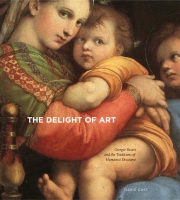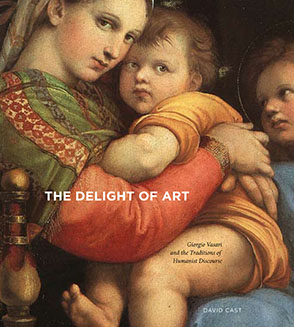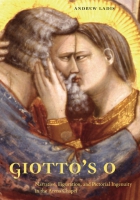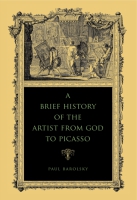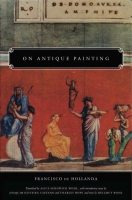The Delight of Art
Giorgio Vasari and the Traditions of Humanist Discourse
David Cast
“Although much of the recent scholarship on Vasari’s great Lives of the Artists has focused on the authorship and production of the book, Cast’s work stands apart as a unique, sustained, and close reading of the whole text, a reading in which the author distills the essence of Vasari’s purposes as a writer. In this respect, there is no work on Vasari quite like Cast’s treatise, which is sophisticated, highly nuanced, and informed by an exceptional philosophical attention to Vasari’s language. I think Cast’s exploration of the concept of ‘attention’ in Vasari enriches our understanding of how art was approached and experienced in the Renaissance.”
- Description
- Reviews
- Bio
- Table of Contents
- Sample Chapters
- Subjects
“Although much of the recent scholarship on Vasari’s great Lives of the Artists has focused on the authorship and production of the book, Cast’s work stands apart as a unique, sustained, and close reading of the whole text, a reading in which the author distills the essence of Vasari’s purposes as a writer. In this respect, there is no work on Vasari quite like Cast’s treatise, which is sophisticated, highly nuanced, and informed by an exceptional philosophical attention to Vasari’s language. I think Cast’s exploration of the concept of ‘attention’ in Vasari enriches our understanding of how art was approached and experienced in the Renaissance.”
“[The] format accommodates rapid-fire insights that capture the breathless excitement of an animated graduate seminar. . . . All students of the Aretine polymath will remain indebted to Cast for identifying and adumbrating Vasari’s latent, even suppressed, theory of delight in art.”
“For those interested in the aesthetic response to art of the Renaissance, The Delight of Art: Giorgio Vasari and the Traditions of Humanist Discourse may be the perfect text.”
David Cast is Professor of the History of Art at Bryn Mawr College.
Contents
List of Illustrations
Preface
Acknowledgments
1. Defining the Terms
2. Talking of Art
3. Thinking About History
4. Describing the Artist
Appendix: The Evening Discussion
Notes
Selected Bibliography
Preface
This is a study of attention and of a moment in the history of the attention given to art. Or, to put this subject in its true history, this study is an attempt to see how we might understand something of the experience of art in the Renaissance, and particularly the artistic attention given to what were then called often the beautiful arts, the most noble arts, that is to say, painting, sculpture, and architecture. It is also an enquiry to see how far this attention or experience might be seen as akin to what now we speak of as the aesthetic response to art, an attention to art as art, apart from all the other interests we can have in it. Yet the terms of this enquiry are elusive. For even if we admit the possibility of any such engagement with the arts—and as the history of criticism shows, this is not a simple issue—we may feel that it is so private and subjective a response as to be beyond the public narratives of history and of the history of the Renaissance, and, as such, a question to which we might never find full answers. Yet, whatever the conclusions, the issues of such an enquiry are deeply interesting at a number of levels, not only for where they might lead us in our account of the culture of the Renaissance and its richness, but also (here I am speaking more personally) because they seem to bring into focus, if in historically different terms, something of the confusions and complexities of our own responses as we stand before the works of the Renaissance: while we recognize them as part of history, they also offer us, as objects so often do, immediate, unhistorical aesthetic experiences. To use an example: I know something of the social and historical significance of the picture of the Mona Lisa, painted as it was five hundred years ago, and this is very much a part of its meaning for me, even as I also recognize it as an object before me calling up a response to its beauty and its deep loveliness.
To consider these questions raises many difficulties. There are matters of definition; and even if we can accept the idea of the aesthetic response to art—if doubtful still what it consists of—we may wonder how far it is proper to speak of such an idea in the Renaissance, long before that moment in the Enlightenment when it became a familiar part of the language of criticism. And then there are problems of evidence, for when we turn to the Renaissance itself, we may feel that most of the critical language used then to speak of art and of the responses to works of art is disappointing, falling off, as a recent historian put it, into mere banalities and cliché. At which point we may feel, sadly, that there is nothing more to do beyond recognizing that if we can accept the aesthetic as a philosophical possibility in our responses to art, there is little in the history of language in the Renaissance that seems ever to take note of anything like this. Again the Mona Lisa; perhaps we might wish to say, with Walter Pater, that its presence is expressive of what in the ways of a thousand years men had come to desire. But the nature of this desire, even its very existence, is something of which, in this silence, we will be forever ignorant.
But this is not the end of the story. Or rather, as I hope to show in all that follows, it may be that when we know where to look, we can indeed find much evidence within the culture of the Renaissance about such a response to art, whatever it is in itself, however at that time it was expressed. And if as philosophers we may worry still about the existence and the character of the aesthetic experience, it might be enough to say, on the model of Wittgenstein, that of course we know what it is, namely, what we all mean by it. And if we come back to look at the critical vocabulary of the Renaissance, we can recognize that, for all the limits of the language, many people did indeed speak of such an idea of pleasure or delight, the delight or art, the art of delight, that a work pleased someone, that someone delighted in art. And there is more, for when we turn to social action and to the discussions of art in the society of Italy, we may sense that a sufficient space was opened up to acknowledge the possibility of such experiences in many of the public activities of the culture, whether in such conversations or in the literary forms of humanism, within the histories of art or in the biographies of the artists. For evidence, we have one magisterial source, Le Vite de’ più eccellenti architetti, pittori e scultori italiani—or, as we will refer to it, The Lives—the treatise about art and artists written by Giorgio Vasari at the instigation of his friend, the writer, collector, and historian Paolo Giovio, published first in Florence in 1550 (figs. 1 and 2) and again in 1568 (fig. 3) in an altered and much expanded edition. This text will be extensively used here for our enquiries about these possibilities, plus much also from humanism and all else, suggested at first by the moral and artistic activities of Dante, Boccaccio, and Petrarch and then elaborated more explicitly over the next two centuries in Italy and beyond by those, whatever their interests, who based their private and public actions on this rich moral and rhetorical program.
<comp: insert figs. 1, 2, and 3 about here>
These, then, as the title and subtitle of this study indicate, are the two points of the enquiry here: the idea of the delight of art; and the cultural facts of this response to art in the culture of humanism, as recognized in Vasari. About delight there will always be much to say, as also about Vasari; but here we need only recognize how easy it was in the Renaissance to take note of this response to things (we can turn to sources speaking of delight as varied as Boccaccio or Lorenzo de’ Medici or Pietro Aretino or Isabella de’Este), be these things jewels or music or the sounds of words or the majesty of a certain abbey. And then we can note how just such a record of delight is there so often in the profuse narrative of Vasari.
But texts, like the facts they recount, are complex. And if we closely examine all that Vasari says of delight both as a response to art and as a property within the art itself, we may sense a certain hesitation always, as we may also note that if necessarily he includes records of such attention in the history he lays out, when, as a critic, he comes to speak of art itself, he generally passes over this possibility, preferring instead to emphasize the properties of art that were more reasoned and more public, namely rule, order, design, and so on, the advances, as he puts it, that had made the achievements of his moment so perfect. Such a contradiction or hesitation, whatever its final meaning, hangs over the whole narrative, as it does over humanist criticism and all the parts of classical rhetoric Vasari uses to define his own particular position. If, as we can show, many of the social and intellectual practices of humanism worked to encourage such an idea of delight, much else in the culture, as we can also show, was there to block any more open critical acknowledgment of anything of this kind as being either acceptable or proper. The result in our reading of Vasari is then very interesting: the evidence we will use comes perhaps less from his notes on criticism than from the fleeting moments within the narrative that speak of such responses or from the facts of history he recounts or the biographies he writes, which make up so much of the text. We might also add that when we turn to Vasari’s account of his first engagement in this project with Giovio, it is clear that such a response to the arts, whatever its exact nature, had became institutionalized as a matter of social practice and as an appropriate way for those Vasari called the gallants and men of letters—and even for Cardinal Alessandro Farnese, in whose presence this conversation took place—to look at art and speak of the reactions possible to the achievements of the artists. But still there was this contradiction. For if this idea of delight was indeed encouraged within humanism, so too always, in another range, there were other forces beyond and within this same tradition that worked to discourage the expression of anything so private, whether the political and cultural programs of Duke Cosimo I, under whom Vasari was to work, or that public discourse on the arts, defined in the language of the academy, the Accademia del Disegno, where also, in the 1560s, he was to play so vital a part.
As even those who decry the baleful influence of Vasari’s text must acknowledge, it may be seen as the most important account of the visual arts ever written. For, like The Prince and The Courtier, those other exemplary and vital commentaries of the sixteenth century, it not only served to bring together much of what had been said of art within the traditions of humanism, but it demonstrated, in a narrative of incomparable richness, how within those terms a history of the arts could be described and defined. This is not to say that Vasari was ever read as widely as Machiavelli or Castiglione; certainly there were no editions or translations of this text to rival those of The Prince or The Courtier that appeared so quickly and so often throughout Europe. Indeed, despite all the signs of interest in Vasari—we learn of these volumes becoming soon rare and expensive—it was not until the next century that a new edition of the text itself appeared, in Bologna in 1647, corrected for what were seen to be its many faults and omissions. But Vasari did not stand by himself; and if there were moments when his text was ignored, the subject it spoke of had particular authority, as did the artists it celebrated, Leonardo and Raphael and Michelangelo and all the others, whose reputations, if subject ever to change, remained ever an indissoluble part of the culture of Europe. As also, for so many years, did the institutions from which this text came, the courts and academies of Italy.
What Vasari wrote is thus an indispensable, even inescapable part of the history of the Renaissance and the history of that history. And even if we can imagine that by their works alone these artists would have been assured of an eternal fame, all that Vasari said of them, even in criticism, served to confirm their place within the culture of Europe in ways that many later artists and writers would always recognize. There could, of course, be a history of Renaissance art without Vasari, but it is difficult to imagine what it would be. And even if at moments we might feel that we could be better placed to understand the real history of Renaissance art (whatever that is), without such a narrative defining what we do, to ignore what Vasari wrote is at once impossible and self-defeating. Perhaps if ever we feel the need for a first defense against his overpowering influence, we might tally up his various vices and his virtues: that he was too prejudiced in his preferences for Florence and the Tuscans (as Giovanni Bellori said, writing in the seventeenth century), yet he was to be praised (said Francesco Sussino in the eighteenth century) for having been the first to attempt anything of this kind; that he left many artists out (said A. F. Rio in the nineteenth century), yet what he wrote, if often coarse and incorrect (as Alexander Chalmers put it in 1816 in his General Biographical Dictionary), was full of information. In the modern moment, criticism took on other tones; as Bernard Berenson put it, Vasari, with all the naiveté of a Herodotus, wrote down merely the folklore, romance, and gossip of the world of art in which he was reared; that in all its inventivenes,s his narrative served merely to distract us from looking more carefully at the forms of art, as Robert Langton Douglas said in the first years of the last century. And even now, in both popular and more specialized writings, writers will frame the corrections of fact they are offering or the purpose of their research by first saying that Vasari misunderstood something—the importance of Pietro Cavallini, for example—or that, as with the work of Masaccio and Masolino at the Brancacci Chapel, he did not document the facts of history as fully as he could have. Which, thinking of how we know what we know, is testimony still to his eternal utility.
Another commentary about this text has recently been added, that possibly some of it, especially in the historical and critical prefaces, was not written by Vasari himself but by his humanist colleagues, Pier Francesco Giambullari or Carlo Lenzoni or Cosimo Bartoli or Vincenzo Borghini, whodid much more for him than the mere editing or revision we know of from their correspondence. This suggestion has led to an ever more scrupulous reading of the text itself and its sources and historical accountings. But for our purposes such a question does not matter, and however much at moments still we might slip into judging Vasari or speaking of his intentionality—I know I will be guilty of this—what is important here is the text itself as a text, whoever wrote it, for whatever reasons. Perhaps, as Hans Belting has suggested, we are at the end of both the history of art and of its narrative; only time will tell. But if so, it is clear, as he notes, that such a history began with this text, as it is equally clear that much of what later was said about the arts, whether this debt was acknowledged or not, had its first groundings or definition in the account of art laid out so clearly by Vasari. As an example, we might take note of the forthcoming studies by Carlo Ginzburg of Vasari’s place within the criticism of the nineteenth century, which speak of the continuing force and complexityof his critical authority among the national traditions of Europe. The reasons for such authority are not difficult to understand; not only did Vasari lay out an account of the arts at a particularly crucial moment in their history, the Renaissance, but he did so in terms that were based on what was acceptable for years, both as politics and as art, within the larger cultures of Europe.
Yet in this account, whatever else was there, it was important that Vasari took up a particular and successful stance on the nature of the arts and the responses appropriate to them. The language of art after Vasari became over the years ever richer in its texture and discriminations, as the writings of Filippo Baldinucci, Giovan Pietro Bellori, and many other later critics show. But still the possibility of the aesthetic cognition of things, mediating between the generalities of reason and the particulars of sense, if suggested here, was not to reappear openly or publicly for more than two centuries, when at last the traditions of humanism were overwhelmed by philosophical and political forces that called into question both such an account of culture and the forms of actions that kept this culture in its place. By then, in the nineteenth century, all that was recognized of this earlier moment were the examples of its art, the paintings and pieces of sculpture and architecture of the Renaissance, reinterpreted to fit the expectations of a modern conscience, a new Raphael, a new Leonardo, a new Michelangelo. And if any allusions were made to the older values of humanism or to the narratives in Vasari, these appeared most in texts like the sentimental legend of Fra Filippo Lippi, as told by A. J. Anderson, or in the poems of Robert Browning or the essays of Walter Pater, or in the pictures by Philippe-Auguste Jeanron, a translator of Vasari in the 1840s, where represented again are the classic stories of the artists: the famous episode of Raphael and La Fornarina, or that of Fra Bartolommeo, or that of Tintoretto and his daughter Maria. Much in this vein was done to the story of the end of Leonardo, dying in the arms of his patron and friend, the king of France, as in pictures by Richard Cosway, Ingres, François-Guillaume Ménageot, and others who, with the collapse of the old order, could now only wish for patrons like those of the past, the Medici or Pope Julius II or Pope Leo X, or a sovereign like Francis I who, they believed, had done so much always to support the arts.
But the criticism of Vasari was turning now into the practices of history. Like Karl Friedrich Rumohr, who found it helpful to use Vasari in his Italienische Forschungen of 1827, many historians turned to The Lives—such refreshing reading, as Jacob Burckhardt described it—whether as a source for their own histories of the Renaissance or as a guide to the monuments of art, or even on occasion to track down frescoes in Florence long hidden under whitewash or grime. And at the end of the century, with the opening of the archives, scholars like Gaetano Milanesi, Ugo Scoti-Bertinelli, Wolfgang Kallab, Alessandro Del Vita, and Karl Frey turned new attention to the text of The Lives and to all the other notes and letters of Vasari that had survived and could be used for understanding of what he had done. Of their labors we are still all the beneficiaries.
But where then within such a tradition does this study stand? There has been much interesting work done recently on the idea of the spectator in the Renaissance. Yet when I think back to the first intimations of this study, I gladly recognize how much I was stimulated by a review Michael Baxandall wrote in 1980 on the occasion of the publication of lectures on Vasari delivered a few years earlier in Washington by T. S. R. Boase. In phrases of characteristically elusive brilliance, he noted how much was to be read in what he called the Vasarian moralistic tangent, the Vasarian critico-mythic anecdote, and all the other devices that made Vasari, as Baxandall put it, an idiomatic mouthpiece for a collective view of itself that the previous centuries had accumulatively worked out. And 1550, Baxandall added, was an especially benign moment for such a critical catch. There was much else in this review, but what seemed to me especially important was the particular sense Baxandall suggested of the historical place of Vasari, as well as his emphasis on the range and richness of the language Vasari used to describe the achievements of the artists he spoke of. I have also been much helped by the work on spectatorship by Wolfgang Kemp, and particularly a review he wrote, a decade after Baxandall, of John Shearman’s magisterial book, Only Connect: Art and the Spectator in the Italian Renaissance, which was a product of the very same series in Washington, the A. W. Mellon Lectures on the Fine Arts, where Boase had spoken. I have also taken much from the work of Robert Gaston on the idea of attention. Most recently, I have been confirmed here by studies on the criticism of the Renaissance by Hellmut Wohl and Philip Sohm, though unfortunately they appeared when this study was almost completed. At a wider range, I have also learned much from the work of Georges Didi-Huberman.
Yet, I would like to think, there is a particular distinction in my account of art, even if, like its subject, such a distinction is difficult to define. I noted at the beginning that the subject of this enquiry is attention and the history of that attention. I spoke of my purpose in this way because I hoped to add to our understanding of the particularity of the experience of art in the Renaissance and of the historical presence of the attention which all then, whether artist or spectator, brought to what they looked at. Or, as Kemp put it, we have to realize that what is so often referred to as the natural, geometric definition of the beholder’s point of view—and this was an idea Shearman, after some qualms, seems to have accepted in his account—is deeply charged historically, as is the construction of the ideal beholder of art, who, in this sense, is never truly an ideal. Nor, of course, is our experience of this art, all matters of immediate perception aside, as inescapably we bring to what we see all that history and our knowledge of that history—even the idea of pure, aesthetic attention—adds to our attention to art. Perhaps such an accounting limits our possibility of any direct experience of art. Yet perhaps not; for if works of visual art are doomed to be forever voiceless, silent poetry, as the great Simonides put it, in this way we can recognize ourselves as part of the history of spectators, thereby lifting something of such silence to allow us to join the noisy company of all those over the ages who have talked about this art and so openly noted their delight in it. This, then, may be of comfort. And it is as a symbol of this endless possibility, whatever also scholarship might demand, that I have taken effort here to include so many quotations from Vasari himself and the traces we have of all those now-lost conversations about artists and their works in his narrative, plus all the lesser-known sentences about art and conversation from the classical and humanist writers he quotes and refers to. At this point I am also pleased to say how much I owe in writing this to the work of Paola Barocchi and Salvatore Battaglia, the first being so rich in its documentation of language of Renaissance criticism, the other so clear in its sense of the history of the Italian language and the complex and subtle changes in its meanings over the years. If I seem widely read in the criticism of the Renaissance, this is in large measure because I learned how to make good use of the work of these scholars as I first marked my way through the language of the arts in the Renaissance at that benign moment of criticism—to quote Baxandall again—when Vasari was at work.
Two last points. The text of Vasari I use here is that first put out by Gaetano Milanesi between 1878 and 1885 and reprinted, as in the much-thumbed copy I have, in Florence in 1973. The edition of Vasari by Rosanna Bettarini and Paola Barocchi, which they began to publish in 1966, is more precise philologically, and the printing there of the parallel texts of the editions of 1550 and 1568 is very practical. But when I began to work on Vasari, it was into Milanesi that I sunk my scholarly teeth, and if I stay still with this edition my reason, it is not only from sentimentality but because I sense this is the edition people own and remain still more comfortable with. And then the footnotes. These I have tried to keep as specific as possible, limiting the citation of secondary materials to what has been of most particular value in the historical and critical narrative I have laid out. But I have also worked hard to include all the material cited here from Vasari and from the other literary sources to allow readers to go without delay to the evidence of language upon which the conclusions in the text are so often based. And if much of this material, whether in Latin or in Italian, is not fully translated, I hope that something will shine through of the complexity and resonance of the language of the arts—if also its limits—as it was used by Vasari and his humanist colleagues and those who went before them.
Also of Interest
Mailing List
Subscribe to our mailing list and be notified about new titles, journals and catalogs.
